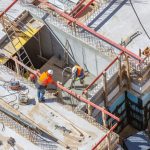Features - Business
Construction struggles through Spring

The latest monthly update from ONS on construction output shows that the industry is struggling with market conditions over the early part of the year.
Output has increased by just 0.2% in volume terms over March, with just four out of the nine sectors seeing a rise. Main contributors to the monthly increase were infrastructure new work and public other new work, which increased 2.2% (£51M) and 6.5% (£48M), respectively.
The largest negative contributors were non-housing repair and maintenance, which decreased 1.8% (£56M) and was the main contributor to the fall in repair and maintenance, and private new housing, which decreased 1.4% (£45M), partially offsetting the increase in total new work. The private housing sector has seen a slowdown since the end of 2022 with five monthly falls out of the last seven.
Anecdotal evidence highlighted the effect of weather, in January 2023 in particular, with firms noting that adverse weather conditions increased the need for repair work. Improved weather in February 2023 allowed for more work to be done in general.
However, the outlook from the quarter is more reassuring, construction output increased 0.7% compared with Quarter 4 (Oct to Dec) 2022; the increase came solely from a rise in repair and maintenance (4.9%), as new work saw a decrease of 1.9%.
This is the sixth quarter of consecutive growth in the quarterly series since Quarter 3 2021, however, the quarterly growth has slowed in comparison with the first half of 2022. Construction output across the months within Quarter 1 2023 was volatile, with a fall of 1.6% in January 2023, followed by two months of growth in February and March 2023, 2.6% and 0.2%, respectively.
The quarterly growth came from an increase in repair and maintenance (4.9%), partially offset by a decrease in new work (1.9% fall).
More worryingly, construction new orders saw a decrease of 12.4% (£1,571M) in Quarter 1 2023 compared with Quarter 4 2022; this quarterly fall came mainly from private commercial and private housing new orders, which fell 22.3% (£773M) and 18.4% (£607M), respectively.
Anecdotal evidence from the Monthly Business Survey for Construction and Allied Trades (MBS) suggested an easing of inflation and material costs. Despite this, some businesses still noted customers hesitating to request work because of economic worries.
The annual rate of construction output price growth was 8.5% in the 12 months to March 2023; this has slowed slightly from the record annual price growth found in May and June 2022 (10.4%).
The largest negative contributor was private new housing, which fell 5.3% (£543 million). Anecdotal evidence suggests a general slowdown in housing across recent quarters, particularly referencing economic uncertainty causing delays and customers hesitating to request work.
Tony Wells, CEO at Merit, said: “March’s construction output tells a familiar story, with tough trading conditions, prolonged inflation, and a dampening labour market. However, each of these factors plays a bigger part in what is a wider productivity problem within the construction industry.
“Today’s figures show an opportunity for the industry to find a different way of working to overcome long-term productivity stagnation, in which industrialised construction and digital manufacturing will play a key role.
“Whilst there is a welcome spotlight now on offsite construction from the Government, the problem remains that they are asking an industry that is vested in maintaining the status quo and not yet invested in delivering real change. Construction firms need to stay close to stakeholders’ needs and find intuitive ways to adapt their offering. At present the UK construction industry’s investment lags behind the OECD average of 2.6%, at a paltry 0.48% – without investment in R&D, the industry will remain stagnant.
“It is only through disruptive innovation and by making a commitment to doing things differently, that we will see a true change.”
If you would like to read more stories like this, then please click here
Related Articles
More Features
- Ten years of progress on payment, pre-qualification and skills
19 May 25
The industry has made significant progress on late payment, pre-qualification, and competence since the formation
- Pagabo provides clarity on impacts of new NPPS and PPNs
12 Mar 25
The Labour government’s new National Procurement Policy Statement (NPPS) sets out strategic priorities for public
- How is the Procurement Act going to drive social value
24 Feb 25
The regulations laid out within the Procurement Act 2023 will go live today.






